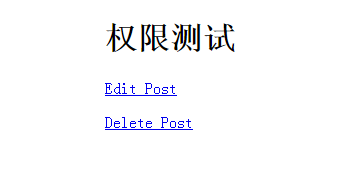您好,登录后才能下订单哦!
这篇文章将为大家详细讲解有关如何在Laravel5.1框架中使用 ACL权限控制系统,文章内容质量较高,因此小编分享给大家做个参考,希望大家阅读完这篇文章后对相关知识有一定的了解。
1. 创建角色与权限表
使用命令行创建角色与权限表:
php artisan make:migration create_permissions_and_roles --create=permissions
之后打开刚刚创建的文件,填入下面的代码:
public function up()
{
Schema::create('roles', function (Blueprint $table) {
$table->increments('id');
$table->string('name');
$table->string('label');
$table->string('description')->nullable();
$table->timestamps();
});
Schema::create('permissions', function (Blueprint $table) {
$table->increments('id');
$table->string('name');
$table->string('label');
$table->string('description')->nullable();
$table->timestamps();
});
Schema::create('permission_role', function (Blueprint $table) {
$table->integer('permission_id')->unsigned();
$table->integer('role_id')->unsigned();
$table->foreign('permission_id')
->references('id')
->on('permissions')
->onDelete('cascade');
$table->foreign('role_id')
->references('id')
->on('roles')
->onDelete('cascade');
$table->primary(['permission_id', 'role_id']);
});
Schema::create('role_user', function (Blueprint $table) {
$table->integer('user_id')->unsigned();
$table->integer('role_id')->unsigned();
$table->foreign('role_id')
->references('id')
->on('roles')
->onDelete('cascade');
$table->foreign('user_id')
->references('id')
->on('users')
->onDelete('cascade');
$table->primary(['role_id', 'user_id']);
});
}
public function down()
{
Schema::drop('roles');
Schema::drop('permissions');
Schema::drop('permission_role');
Schema::drop('role_user');
}上面的代码会创建角色表、权限表、角色与权限的中间表以及角色与用户的中间表。
2. 创建模型
接下来使用命令行分别创建角色与权限模型:
php artisan make:model Permission php artisan make:model Role
然后分别打开Permission.php、Role.php 以及 User.php ,加入下面的代码:
// Permissions.php
public function roles()
{
return $this->belongsToMany(Role::class);
}// Role.php
public function permissions()
{
return $this->belongsToMany(Permission::class);
}
//给角色添加权限
public function givePermissionTo($permission)
{
return $this->permissions()->save($permission);
}// User.php
public function roles()
{
return $this->belongsToMany(Role::class);
}
// 判断用户是否具有某个角色
public function hasRole($role)
{
if (is_string($role)) {
return $this->roles->contains('name', $role);
}
return !! $role->intersect($this->roles)->count();
}
// 判断用户是否具有某权限
public function hasPermission($permission)
{
return $this->hasRole($permission->roles);
}
// 给用户分配角色
public function assignRole($role)
{
return $this->roles()->save(
Role::whereName($role)->firstOrFail()
);
}上面的代码实现了给角色分配权限及给用户分配角色,然后还提供了判断用户是否具有某角色及某权限的方法。
之后就给使用Laravel提供的Authorization来定义权限控制了,打开 /app/Providers/AuthServiceProvider.php 文件,在 boot() 中添加代码:
public function boot(GateContract $gate)
{
parent::registerPolicies($gate);
$permissions = \App\Permission::with('roles')->get();
foreach ($permissions as $permission) {
$gate->define($permission->name, function($user) use ($permission) {
return $user->hasPermission($permission);
});
}
}通过上面的方法就定义好了各个权限。下面就该填充数据了。
3. 填充数据
为方便起见,这里使用 tinker 命令行工具来添加几条测试数据:
php artisan tinker
之后进入命令行,依次输入下列命令:
// 改变命名空间位置,避免下面每次都要输入 App namespace App // 创建权限 $permission_edit = new Permission $permission_edit->name = 'edit-post' $permission_edit->label = 'Can edit post' $permission_edit->save() $permission_delete = new Permission $permission_delete->name = 'delete-post' $permission_delete->label = 'Can delete post' $permission_delete->save() // 创建角色 $role_editor = new Role $role_editor->name = 'editor'; $role_editor->label = 'The editor of the site'; $role_editor->save() $role_editor->givePermissionTo($permission_edit) $role_admin = new Role $role_admin->name = 'admin'; $role_admin->label = 'The admin of the site'; $role_admin->save() // 给角色分配权限 $role_admin->givePermissionTo($permission_edit) $role_admin->givePermissionTo($permission_delete) // 创建用户 $editor = factory(User::class)->create() // 给用户分配角色 $editor->assignRole($role_editor->name) $admin = factory(User::class)->create() $admin->assignRole($role_admin->name)
上面我们创建了两个权限:edit-post 和 delete-post,然后创建了 editor 和 admin 两个角色,editor 角色拥有 edit-post 的权限,而 admin 两个权限都有。之后生成了两个用户,分别给他们分配了 editor 和 admin 的角色,即:ID 1 用户拥有 editor 角色,因此只有 edit-post 权限,而 ID 2 用户拥有 admin 角色,因此具有 edit-post 和 delete-post 权限。下面我们来验证下是否正确。
打开 routes.php 文件:
Route::get('/', function () {
$user = Auth::loginUsingId(1);
return view('welcome');
})上面我们先验证 ID 1 用户的权限,然后修改 /resources/views/welcome.blade.php 文件:
<!DOCTYPE html>
<html>
<head>
<title>Laravel</title>
</head>
<body>
<h2>权限测试</h2>
<p>
@can('edit-post')
<a href="#" rel="external nofollow" rel="external nofollow" >Edit Post</a>
@endcan
</p>
<p>
@can('delete-post')
<a href="#" rel="external nofollow" rel="external nofollow" >Delete Post</a>
@endcan
</p>
</body>
</html>在视图中我们通过 Laravel 提供的 @can 方法来判断用户是否具有某权限。
打开浏览器,访问上面定义的路由,可以看到视图中只出现了 Edit Post 链接。之后我们修改路由中用户ID为 2 ,然后再次刷新浏览器,可以看到,这次同时出现了 Edit Post 和 Delete Post 两个链接,说明我们定义的权限控制起作用了。

关于如何在Laravel5.1框架中使用 ACL权限控制系统就分享到这里了,希望以上内容可以对大家有一定的帮助,可以学到更多知识。如果觉得文章不错,可以把它分享出去让更多的人看到。
免责声明:本站发布的内容(图片、视频和文字)以原创、转载和分享为主,文章观点不代表本网站立场,如果涉及侵权请联系站长邮箱:is@yisu.com进行举报,并提供相关证据,一经查实,将立刻删除涉嫌侵权内容。